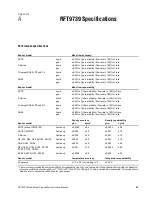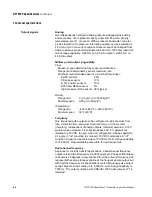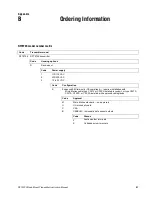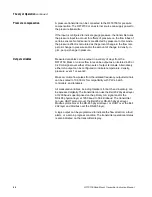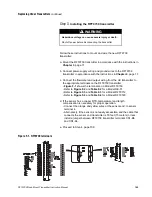
94
RFT9739 Rack-Mount Transmitter Instruction Manual
Theory of Operation
continued
Mass flow measurement
The vibrating motion of the flow tube, combined with the momentum of
the fluid flowing through the tubes, induces a Coriolis force that causes
each flow tube to twist in proportion to the rate of mass flow through the
tube during each vibrational cycle. Since one leg of the flow tube lags
behind the other leg during this twisting motion, the signals from sensors
on the two tube legs can be compared electronically to determine the
amount of twist. The transmitter measures the time delay between the
left and right pickoff signals using precision circuitry and a high
frequency crystal controlled clock. This "delta time" value is digitally
filtered to reduce noise and improve the measurement resolution.
Delta time is multiplied by the flow calibration factor to determine the
mass flow rate. Since temperature affects flow tube stiffness, the amount
of twist produced by the Coriolis force will be affected by the flow tube
temperature. The measured flow rate is continuously adjusted by the
transmitter, which monitors the output of a platinum element resistance
temperature detector (RTD) attached to the outside surface of the flow
tube. The transmitter measures the sensor temperature using a three-
wire RTD bridge amplifier circuit. The voltage out of the amplifier is
converted to a frequency and is digitized by a counter read by the
microprocessor.
Density measurement
The Coriolis mass flow sensor also functions as a vibrating tube density
meter. The natural frequency of the tube assembly is a function of tube
stiffness, tube geometry, and the mass of the fluid the tube contains.
Therefore, fluid density can be derived from a measurement of tube
frequency.
The transmitter measures the time period of each vibrational cycle using
a high-frequency clock. This measurement is digitally filtered, and
density is calculated using the density calibration factors for the sensor
after compensating the sensed natural frequency for known changes in
the tube stiffness due to operating temperature. The transmitter
calculates volumetric flow by dividing the measured mass flow by the
measured density.
API gravity
If
°
API is selected as the density unit, the transmitter calculates standard
volume for Generalized Petroleum Products according to API-2540. The
transmitter calculates volume flow and volume total at 60
°
F or 15
°
C,
depending on the temperature unit:
• If degrees Fahrenheit or degrees Rankine is selected as the
temperature unit, the transmitter calculates volume at 60
°
F.
• If degrees Celsius or Kelvin is selected as the temperature unit, the
transmitter calculates volume at 15
°
C.
From the operating density (fluid density at line conditions) and
operating temperature of a given petroleum fluid, the standard density
(density at 60
°
F or 15
°
C) can be determined directly from API thermal
expansion tables, or by using API equation API-2540:
Summary of Contents for Fisher Rosemount RFT9739
Page 1: ...Model RFT9739 Rack Mount Transmitter Instruction Manual Version 3 Transmitters February 2000 ...
Page 2: ......
Page 4: ......
Page 20: ...10 RFT9739 Rack Mount Transmitter Instruction Manual ...
Page 26: ...16 RFT9739 Rack Mount Transmitter Instruction Manual ...
Page 92: ...82 RFT9739 Rack Mount Transmitter Instruction Manual ...
Page 100: ...90 RFT9739 Rack Mount Transmitter Instruction Manual ...
Page 110: ...100 RFT9739 Rack Mount Transmitter Instruction Manual ...
Page 112: ...102 RFT9739 Rack Mount Transmitter Instruction Manual ...
Page 120: ...110 RFT9739 Rack Mount Transmitter Instruction Manual ...
Page 122: ...112 RFT9739 Rack Mount Transmitter Instruction Manual ...
Page 129: ......




